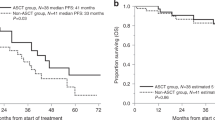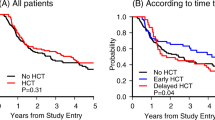Abstract
Multiple myeloma is a disease of the elderly. Survival outcomes remain unacceptably low in older adults with multiple myeloma. To date, no obvious difference in tumor biology has been elucidated to explain the survival disparity between older and younger patients. Multiple factors including comorbidity, performance status, decreased physiologic reserve and potentially undertreatment contribute to poor outcomes in elderly patients with multiple myeloma. High-dose chemotherapy with autologous stem cell transplantation (ASCT) is increasingly being used to treat elderly patients with multiple myeloma in an effort to improve survival outcomes. Recent case comparison studies, and preliminary transplant registry data suggest that selected older patients can be treated with high-dose chemotherapy effectively with similar toxicity and survival benefits compared to younger patients. Traditional upper age limits for autologous transplantation are being challenged along with the definition of ‘elderly’ itself. Ultimately, the role of high-dose chemotherapy with stem cell rescue in the upfront treatment of older adults with multiple myeloma can only be established by prospective randomized trials. In the process of designing studies to investigate the use of ASCT in older patients, multiple issues unique to the elderly population will need to be considered. First, it will be critical to develop and validate patient selection algorithms that incorporate measures of comorbidity, cognitive function, physiologic reserve and psychosocial function to identify patients most likely to tolerate and benefit from ASCT. Second, preparative and conditioning regimens will need to be further tailored to maximize the benefit to risk ratio. Finally, outcome measures in clinical trials should include disability and quality of life measures, which may be equally important in making treatment decisions for older patients. The future application and study of autologous transplantation in older patients with multiple myeloma provides a unique opportunity to challenge ageism and serve as a model for development of tailored assessments and interventions in this population.
This is a preview of subscription content, access via your institution
Access options
Subscribe to this journal
Receive 12 print issues and online access
$259.00 per year
only $21.58 per issue
Buy this article
- Purchase on Springer Link
- Instant access to full article PDF
Prices may be subject to local taxes which are calculated during checkout



Similar content being viewed by others
References
Attal M, Harousseau JL, Stoppa AM, Sotto JJ, Fuzibet JG, Rossi JF et al. A prospective, randomized trial of autologous bone marrow transplantation and chemotherapy in multiple myeloma. Intergroupe Francais du Myelome. N Engl J Med 1996; 335: 91–97.
Child JA, Morgan GJ, Davies FE, Owen RG, Bell SE, Hawkins K et al. High-dose chemotherapy with hematopoietic stem-cell rescue for multiple myeloma. N Engl J Med 2003; 348: 1875–1883.
Fermand JP, Katsahian S, Divine M, Leblond V, Dreyfus F, Macro M et al. High-dose therapy and autologous blood stem-cell transplantation compared with conventional treatment in myeloma patients aged 55 to 65 years: long-term results of a randomized control trial from the Group Myelome-Autogreffe. J Clin Oncol 2005; 23: 9227–9233.
Badros A, Barlogie B, Siegel E, Morris C, Desikan R, Zangari M et al. Autologous stem cell transplantation in elderly multiple myeloma patients over the age of 70 years. Br J Haematol 2001; 114: 600–607.
O'Shea D, Giles C, Terpos E, Perz J, Politou M, Sana V et al. Predictive factors for survival in myeloma patients who undergo autologous stem cell transplantation: a single-centre experience in 211 patients. Bone Marrow Transplant 2006; 37: 731–737.
Palumbo A, Bringhen S, Petrucci MT, Musto P, Rossini F, Nunzi M et al. Intermediate-dose melphalan improves survival of myeloma patients aged 50 to 70: results of a randomized controlled trial. Blood 2004; 104: 3052–3057.
Siegel DS, Desikan KR, Mehta J, Singhal S, Fassas A, Munshi N et al. Age is not a prognostic variable with autotransplants for multiple myeloma. Blood 1999; 93: 51–54.
Kyle RA, Gertz MA, Witzig TE, Lust JA, Lacy MQ, Dispenzieri A et al. Review of 1027 patients with newly diagnosed multiple myeloma. Mayo Clin Proc 2003; 78: 21–33.
Blade J, Munoz M, Fontanillas M, San Miguel J, Alcala A, Maldonado J et al. Treatment of multiple myeloma in elderly people: long-term results in 178 patients. Age Ageing 1996; 25: 357–361.
Rodon P, Linassier C, Gauvain JB, Benboubker L, Goupille P, Maigre M et al. Multiple myeloma in elderly patients: presenting features and outcome. Eur J Haematol 2001; 66: 11–17.
Clavio M, Casciaro S, Gatti AM, Spriano M, Bonanni F, Poggi A et al. Multiple myeloma in the elderly: clinical features and response to treatment in 113 patients. Haematologica 1996; 81: 238–244.
Nilsson T, Hoglund M, Lenhoff S, Rylander L, Turesson I, Westin J et al. A pooled analysis of karyotypic patterns, breakpoints and imbalances in 783 cytogenetically abnormal multiple myelomas reveals frequently involved chromosome segments as well as significant age- and sex-related differences. Br J Haematol 2003; 120: 960–969.
Mileshkin L, Prince HM . The adverse prognostic impact of advanced age in multiple myeloma. Leuk Lymphoma 2005; 46: 951–966.
Cohen HJ, Bartolucci A . Age and the treatment of multiple myeloma. Southeastern Cancer Study Group experience. Am J Med 1985; 79: 316–324.
Palva IP, Ahrenberg P, Ala-Harja K, Almqvist A, Hanninen A, Ilvonen M et al. Treatment of multiple myeloma in old patients. Finnish Leukaemia Group. Eur J Haematol 1989; 43: 328–331.
Wisloff F, Andersen P, Andersson TR, Brandt E, Eika C, Fjaestad K et al. Has the incidence of multiple myeloma in old age been underestimated? The myeloma project of health region I in Norway I. Eur J Haematol 1991; 47: 333–337.
Desikan KR, Tricot G, Munshi NC, Anaissie E, Spoon D, Fassas A et al. Preceding chemotherapy, tumour load and age influence engraftment in multiple myeloma patients mobilized with granulocyte colony-stimulating factor alone. Br J Haematol 2001; 112: 242–247.
Fietz T, Rieger K, Dimeo F, Blau IW, Thiel E, Knauf WU . Stem cell mobilization in multiple myeloma patients: do we need an age-adjusted regimen for the elderly? J Clin Apher 2004; 19: 202–207.
Guba SC, Vesole DH, Jagannath S, Bracy D, Barlogie B, Tricot G . Peripheral stem cell mobilization and engraftment in patients over age 60. Bone Marrow Transplant 1997; 20: 1–3.
Rapoport AP, DiPersio JF, Martin BA, Duerst RE, Kouides PA, Liesveld JL et al. Patients > or=age 40 years undergoing autologous or allogeneic BMT have regimen-related mortality rates and event-free survivals comparable to patients <age 40 years. Bone Marrow Transplant 1995; 15: 523–530.
Dumontet C, Ketterer N, Espinouse D, Neidhardt EM, Moullet I, Thieblemont C et al. Reduced progression-free survival in elderly patients receiving intensification with autologous peripheral blood stem cell reinfusion for multiple myeloma. Bone Marrow Transplant 1998; 21: 1037–1041.
Sirohi B, Powles R, Treleaven J, Mainwaring P, Kulkarni S, Pandha H et al. The role of autologous transplantation in patients with multiple myeloma aged 65 years and over. Bone Marrow Transplant 2000; 25: 533–539.
Reece DE, Bredeson C, Perez WS, Jagannath S, Zhang MJ, Ballen KK et al. Autologous stem cell transplantation in multiple myeloma patients <60 vs >/=60 years of age. Bone Marrow Transplant 2003; 32: 1135–1143.
Jantunen E, Kuittinen T, Penttila K, Lehtonen P, Mahlamaki E, Nousiainen T . High-dose melphalan (200 mg/m2) supported by autologous stem cell transplantation is safe and effective in elderly (>or=65 years) myeloma patients: comparison with younger patients treated on the same protocol. Bone Marrow Transplant 2006; 37: 917–922.
Lenhoff S, Hjorth M, Westin J, Brinch L, Backstrom B, Carlson K et al. Impact of age on survival after intensive therapy for multiple myeloma: a population-based study by the Nordic Myeloma Study Group. Br J Haematol 2006; 133: 389–396.
Terpos E, Apperley JF, Samson D, Giles C, Crawley C, Kanfer E et al. Autologous stem cell transplantation in multiple myeloma: improved survival in nonsecretory multiple myeloma but lack of influence of age, status at transplant, previous treatment and conditioning regimen. A single-centre experience in 127 patients. Bone Marrow Transplant 2003; 31: 163–170.
Facon T, Mary JY, Harousseau J, Huguet F, Berthou C, Grosbois B et al. Superiority of melphalan--prednisone (MP) + thalidomide (THAL) over MP and autologous stem cell transplantation in the treatment of newly diagnosed elderly patients with multiple myeloma. J Clin Oncol (Meeting Abstracts) 2006; 24: 1.
Extermann M . Measurement and impact of comorbidity in older cancer patients. Crit Rev Oncol Hematol 2000; 35: 181–200.
Yancik R, Havlik RJ, Wesley MN, Ries L, Long S, Rossi WK et al. Cancer and comorbidity in older patients: a descriptive profile. Ann Epidemiol 1996; 6: 399–412.
Alamo J, Shahjahan M, Lazarus HM, de Lima M, Giralt SA . Comorbidity indices in hematopoietic stem cell transplantation: a new report card. Bone Marrow Transplant 2005; 36: 475–479.
Sorror ML, Maris MB, Storer B, Sandmaier BM, Diaconescu R, Flowers C et al. Comparing morbidity and mortality of HLA-matched unrelated donor hematopoietic cell transplantation after nonmyeloablative and myeloablative conditioning: influence of pretransplantation comorbidities. Blood 2004; 104: 961–968.
Sorror ML, Maris MB, Storb R, Baron F, Sandmaier BM, Maloney DG et al. Hematopoietic cell transplantation (HCT)-specific comorbidity index: a new tool for risk assessment before allogeneic HCT. Blood 2005; 106: 2912–2919.
Inouye SK, Peduzzi PN, Robison JT, Hughes JS, Horwitz RI, Concato J . Importance of functional measures in predicting mortality among older hospitalized patients. JAMA 1998; 279: 1187–1193.
Extermann M, Overcash J, Lyman GH, Parr J, Balducci L . Comorbidity and functional status are independent in older cancer patients. J Clin Oncol 1998; 16: 1582–1587.
Katz S, Ford AB, Moskowitz RW, Jackson BA, Jaffe MW . Studies of illness in the aged. The index of ADL: a standardized measure of biological and psychosocial function. JAMA 1963; 185: 914–919.
Lawton MP . Scales to measure competence in everyday activities. Psychopharmacol Bull 1988; 24: 609–614.
Repetto L, Fratino L, Audisio RA, Venturino A, Gianni W, Vercelli M et al. Comprehensive geriatric assessment adds information to Eastern Cooperative Oncology Group performance status in elderly cancer patients: an Italian Group for Geriatric Oncology Study. J Clin Oncol 2002; 20: 494–502.
Cesari M, Kritchevsky SB, Penninx BW, Nicklas BJ, Simonsick EM, Newman AB et al. Prognostic value of usual gait speed in well-functioning older people – results from the Health, Aging and Body Composition Study. J Am Geriatr Soc 2005; 53: 1675–1680.
Guralnik JM, Ferrucci L, Simonsick EM, Salive ME, Wallace RB . Lower-extremity function in persons over the age of 70 years as a predictor of subsequent disability. N Engl J Med 1995; 332: 556–561.
Studenski S, Perera S, Wallace D, Chandler JM, Duncan PW, Rooney E et al. Physical performance measures in the clinical setting. J Am Geriatr Soc 2003; 51: 314–322.
Author information
Authors and Affiliations
Corresponding author
Rights and permissions
About this article
Cite this article
Klepin, H., Hurd, D. Autologous transplantation in elderly patients with multiple myeloma: are we asking the right questions?. Bone Marrow Transplant 38, 585–592 (2006). https://doi.org/10.1038/sj.bmt.1705486
Received:
Accepted:
Published:
Issue Date:
DOI: https://doi.org/10.1038/sj.bmt.1705486
Keywords
This article is cited by
-
Efficacy and safety of autologous stem cell transplantation in patients aged ≥ 65 years with multiple myeloma in the era of novel agents
Bone Marrow Transplantation (2019)
-
Real-life data on safety and efficacy of autologous stem cell transplantation in elderly patients with multiple myeloma
Annals of Hematology (2019)
-
Efficacy and safety of autologous hematopoietic cell transplantation in elderly patients with multiple myeloma: a retrospective national multi-site cohort study
Annals of Hematology (2017)
-
High-dose therapy and autologous stem cell transplant in older adults with multiple myeloma
Bone Marrow Transplantation (2015)
-
Endocrine, metabolic, nutritional and body composition abnormalities are common in advanced intensively-treated (transplanted) multiple myeloma
Bone Marrow Transplantation (2014)



